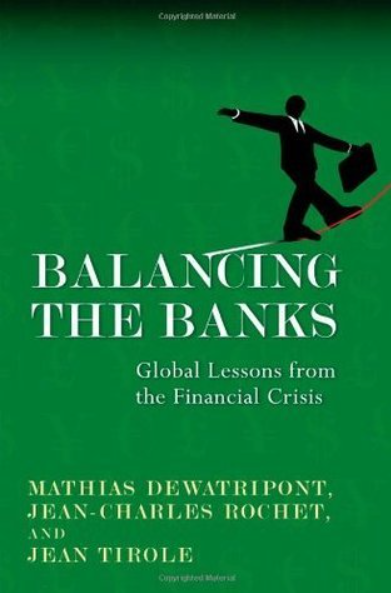Balancing the Banks: Global Lessons from the Financial Crisis by Mathias Dewatripont

CHAPTER 1
Introduction
Mathias Dewatripont, Jean-Charles Rochet,
and Jean Tirole
The recent fi nancial crisis was a mix of “unique” and much
more conventional events. This short book offers our perspective
on what happened and especially on the lessons to be learned in
order to avoid a repetition of this large-scale meltdown of fi nan-
cial markets, industrial recession, and public defi cits. Chapter 2
provides a diagnosis of what went wrong and discusses some key
fi nancial regulation reforms. Chapter 3 takes a more detailed look
at the fl aws in the prudential framework that was in place when
the crisis erupted and at the required remedies, and chapter 4 fo-
cuses on the treatment of distressed banks, a key element of this
prudential framework. This introduction takes a more general
look at the rationale for and challenges of banking regulation.
Regulation in a Historical Perspective
What degree of regulation of the banking sector is appropriate
has been a controversial question for almost a century. The Great
Depression, with its wave of bank failures triggered by bank runs,
led in the 1930s to heavy-handed regulation, combining deposit
insurance, interest-rate regulations, barriers to entry, restrictions
on activities (compulsory specialization), and constraints on bank
size. Although the succeeding decades witnessed a return to sta-
bility, the banking system gradually became perceived as ineffi -
cient and poorly innovative. In order to encourage cost-cutting
and innovation, and to induce banks to pass effi ciency gains on
to consumers, governments deregulated the banking industry and
fostered competition from the 1970s on. This trend was also the
result of pressure from commercial banks, which were facing
competition from other less regulated fi nancial institutions (e.g.,
money-market mutual funds and investment banks).
Although details vary from country to country, the removal of
interest-rate controls promoted competition at fi rst. In the tur-
bulent macroeconomic environment of the 1970s and 1980s,
though, this form of deregulation, together with an interest-rate
maturity mismatch in a period of rising interest rates, resulted in
the 1980s in a large-scale banking crisis in the United States (the
savings and loan—S&L—crisis). This crisis led to a mix of further
deregulation and reregulation. On the one hand, diversifi cation
of activities was allowed in order to reduce the specialization-
induced fragility of the S&Ls. S&Ls had used short-term sav-
ings deposits to fund long-term, fi xed-rate mortgages, and were
thereby exposed to yield-curve risk. On the other hand, in order
to limit the exposure of deposit insurance funds, the regulation
of solvency ratios became more stringent and intervention rules
in case of violation of these ratios were strengthened.
This emphasis on prudential regulation and the desire to har-
monize country-specifi c capital adequacy requirements led to the
international standard embodied in the Basel system of regula-
tion. New international regulations, including the 1988 accords,
were intended to ensure a level playing fi eld in a world of in-
creasing globalization of banking. Subsequent events made this
attempt to establish a level playing fi eld, however imperfect in
practice, seem prescient since large international banks have now
become common in the United States, Europe, and Asia.
This internationalization and the intensifi cation of competi-
tion among various marketplaces (e.g., between Wall Street and
the City of London) led to a weakening of regulatory standards,
fed by pressure from large banks, themselves facing competition
from more lightly regulated fi nancial institutions. One can inter-
pret the recent modifi cation of the Basel capital adequacy rules
(Basel II), which allow large banks to reduce effective capital ra-
tios if they can show that their risks are “limited,” as an outcome
of lobbying by these banks. The assessment of risk under the
new regulations comes from the banks themselves, through “in-
ternal models”—which represents a step toward self-regulation.
The complexity of these internal models can make it very hard
for supervisors to verify what is being computed and raises con-
Balancing the Banks: Global Lessons from the Financial Crisis by Mathias Dewatripont




